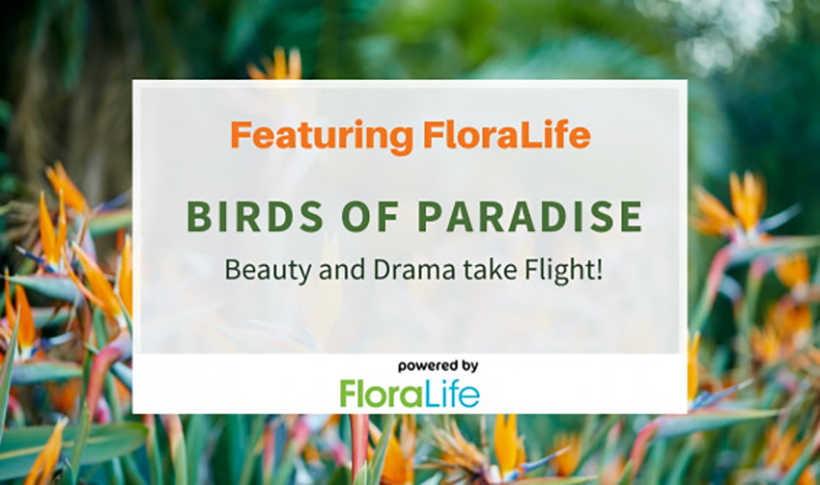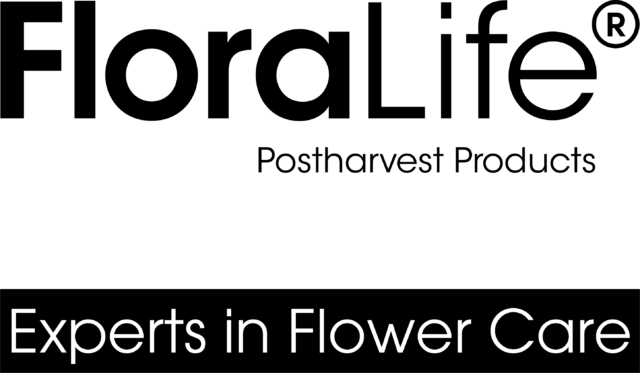Birds of Paradise: Beauty and Drama take Flight!
Floriology Institute August 2021, powered by FloraLife

Birds of Paradise…you really have to appreciate the romantic, sometimes whimsical common names given to flowers, as their scientific designations often leave you cold! Ask yourself which flower sounds more enjoyable: one named for a beautiful tropical bird, or one named for the 18th century Duchy of Mecklenburg-Strelitz?
Regardless, whether you prefer your nomenclature vivid and romantic or cool and scientific, you are sure to enjoy the exotic drama of the Bird of Paradise (Strelitzia reginae).
A native of South Africa, Birds are definitely a change of pace from the often delicate, frilly world of cut flowers, and you won’t find a subtle pastel in the bunch! Symbolic of faithfulness, love, and thoughtfulness, Birds epitomize romance (with perhaps a touch of drama!) And, hopefully, the romance and excitement will be as long-lasting as the birds themselves; with proper care these hardy tropical flowers can last two weeks or more in the vase.
Birds are generally available throughout the year, so it’s always the right time to make a big bold statement. And if you want to make it a lasting statement, follow these valuable care and handling tips:
Purchasing:
- Know the flower’s origination and cultivar – cultivar selection may affect vase life.
- Determine if blooms have been stored wet or dry – dry storage may be detrimental if proper measures to retain moisture in the shipping box are not taken.
- Treatment with an ethylene inhibitor such as EthylBloc™ is recommended.
- Choose stems with large, fully formed bracts to ensure proper opening and development.
Processing:
- Start processing with a clean bucket, sanitized with FloraLife® D.C.D.® cleaner.
- Place stems in a hydration solution, especially if they were transported dry. FloraLife® Quick Dip will condition the stems and promote uptake. Fill buckets with water mixed with flower food solution according to manufacturer’s recommendation. Do not put flowers directly in metal/galvanized buckets. Use clean, high quality water that has not been treated with a water softener as the salt levels can be damaging to flowers.
- Remove foliage below solution level.
- Cut approximately 1” or more off stems. Use clean, sanitized clippers or knife.
- Place flowers in prepared container.
- Allow minimum 2 hours to hydrate placing buckets in an area with good airflow.
- Always remember FIFO (first in/first out) when rotating Birds or any other flowers.
Storage:
- Bird of Paradise are less cold sensitive than other tropical flowers like Heliconia and Red Ginger. Generally, tropical flowers should be stored at 55˚ F / 13° C; however, Bird of Paradise can be stored as low as 45˚ F / 7° C without risk of chilling injury. Recommended humidity levels during storage are 85%.
Common Defects:
- Split leaves (damage during shipping)
- Brown, shriveled bract tips (desiccation)
- Burning of leaf tips and margins (desiccation)
- Softened and slimy stems (poor sanitation)
- Floret and bract browning/blackening (chilling injury)
- Floret browning and bract lesions (botrytis)
Special Considerations:
When Birds of Paradise perish early, it is most often a function of poor water uptake. Pay special attention to the health of the stems, cutting and replacing flower food solution as necessary.
Read the full article on: www.floriologyinstitute.com
To learn about best practices from the experts in flower care or to inquire about products and availability in your region, visit www.floralife.com or contact your local FloraLife representative.
*Product availability depends upon geographical region.
